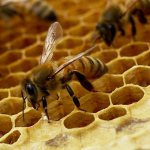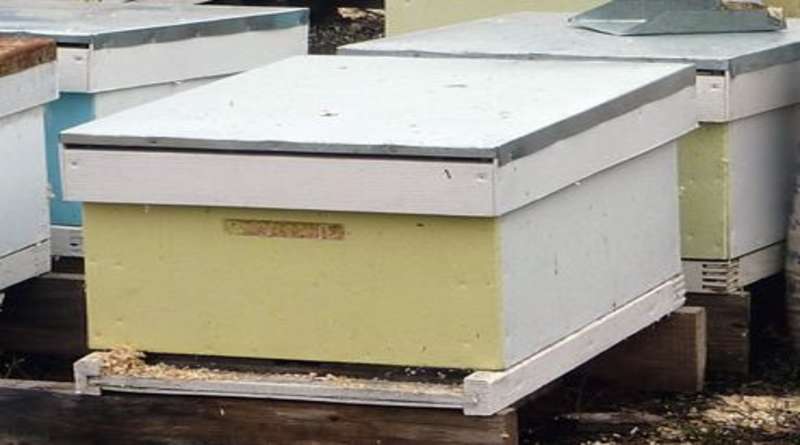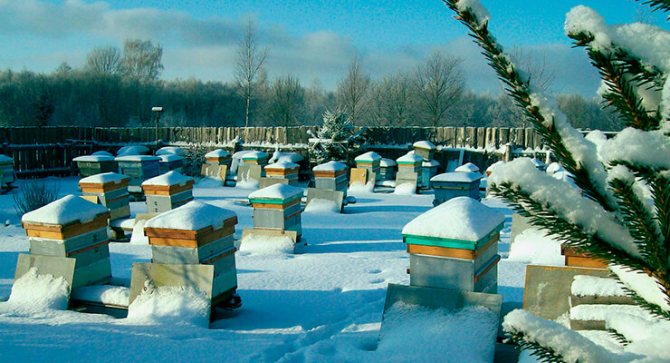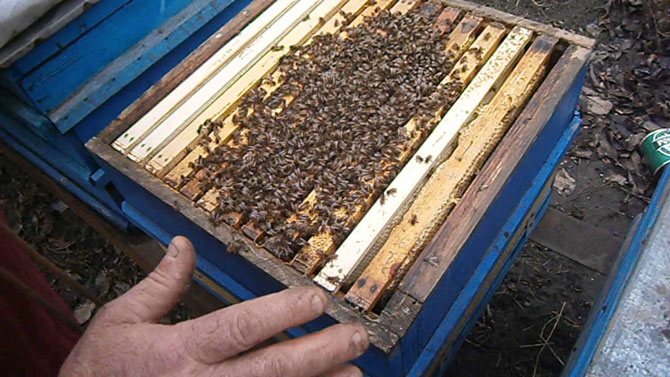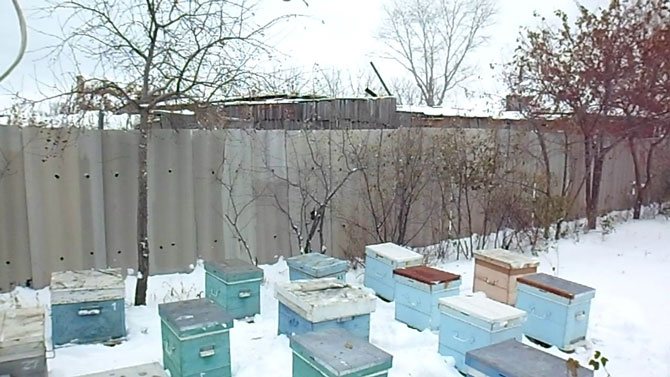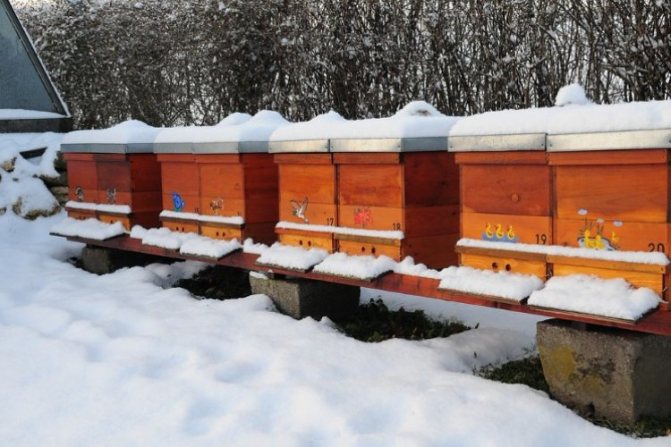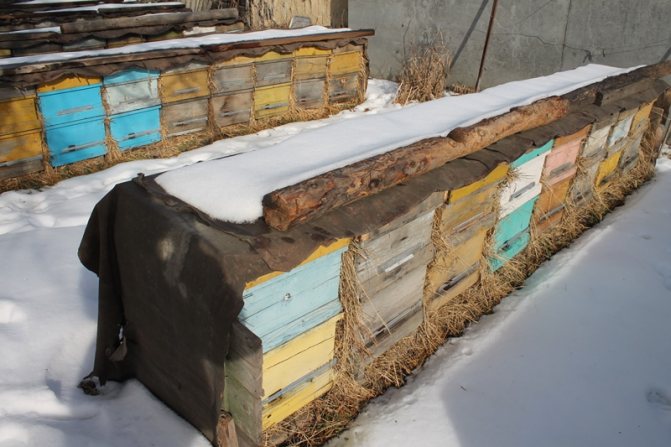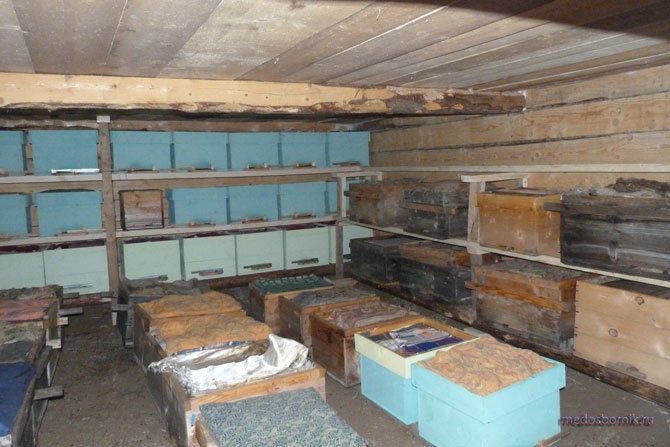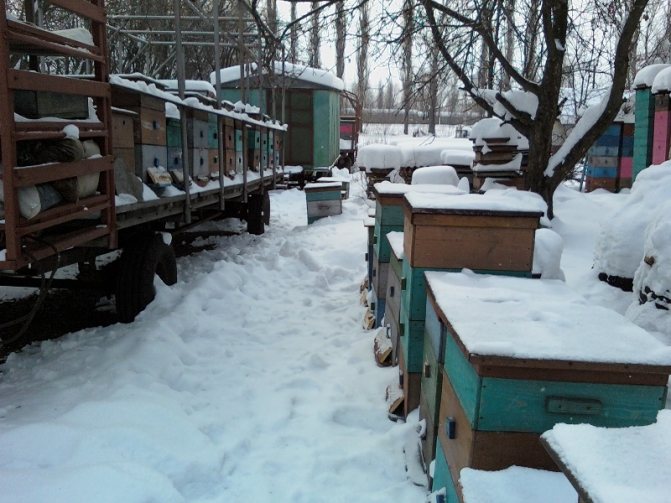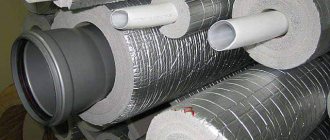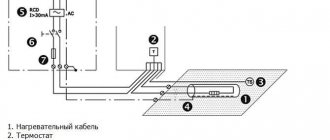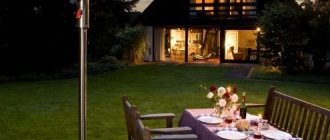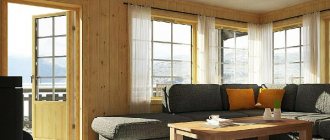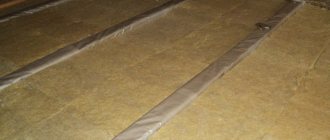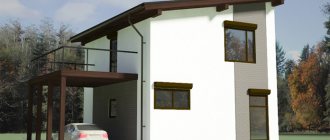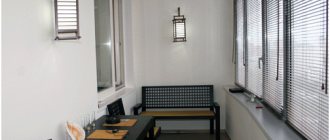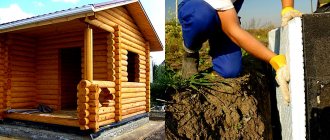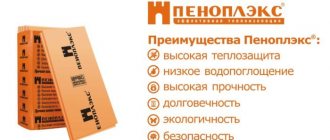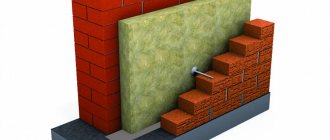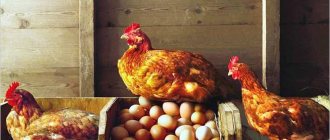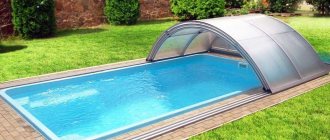Method essence
A logical question arises: how do bees hibernate on the street and do not freeze? Nature has thought out and arranged everything so that the bees manage to survive and accumulate enough energy for spring outings. The trick lies in the fact that the bee colony is a well-coordinated mechanism, each "screw" of which performs certain functions.
As soon as the cold sets in, the family huddles into a winter club. Young growth concentrates inside it, generating heat. The old bees, in turn, form an insulating layer to maintain the optimum temperature inside the club. Now do you understand how bees winter on the street without additional insulation?
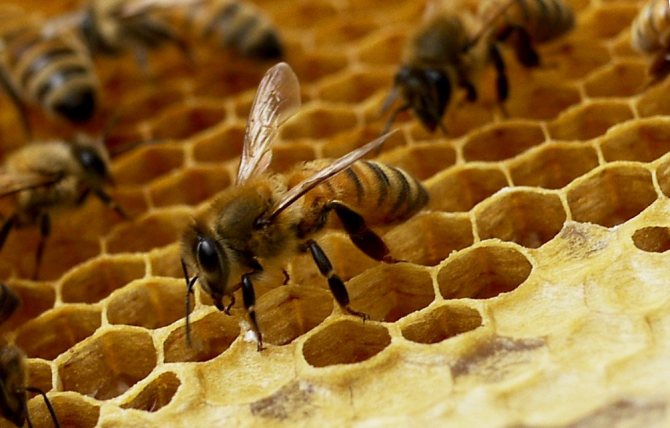
It turns out that nature has created all the conditions for wintering bees in the wild. Insects nestle tightly against each other and thereby protect the uterus and young animals. It is worth noting that it is in winter that the uterus lays eggs and lays the foundation for extending the life of the family. With the onset of warmth, bees begin to fly regularly, gradually moving away from winter passivity.
Features of wintering bees on the street
Before answering the main question, let's get back to the origins. Striped workers appeared on Earth several million years ago. Naturally, there were no people then and no one could tame insects. Scientists have found that the bees hibernated in the hollows of trees. From this we can conclude that, according to the idea of nature, insects are able to maintain a population even in the most severe conditions. This explains the fact that several thousand years ago our ancestors collected wild honey in central Russia and the Urals.
It turns out that hives for wintering can be freely installed outside. Bees are able to safely survive the cold and delight their owners with delicious honey.
Rules and conditions for wintering bees on the street
- It is important to carefully control the stocks of food, if necessary, prepare top dressing for the successful wintering of insects on the street.
- Only strong families can survive the winter, therefore the weak can die during the cold season.
- If necessary, it is advisable to join a weak family to a strong one, so the chance of its survival increases.
- It is necessary to exclude the influence of external irritating factors so that the houses are quiet.
Nutrition of bee colonies in winter
In winter, the family's food consumption is 18 - 25 kg of honey. The feed is pre-sealed for safe storage. The bee club is gradually moving upward, eating supplies. At the same time, free sealed honeycombs are occupied. It is advisable to select frames in dark shades.
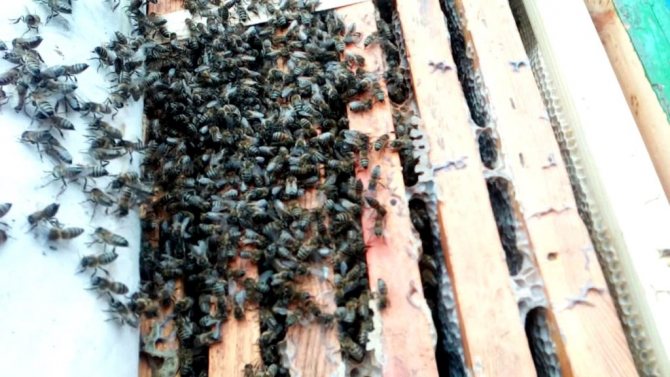

The feed consumption depends on the quality of the hive. Warmth, low humidity and high-quality ventilation guarantee minimal consumption. A strong family is able to independently make the required amount of reserves for the winter. The harvested honey is stored in a thick form. Insects travel around it with specific glands. The required moisture is taken from the vapor produced during breathing. Excess moisture spoils honey, causing death.
During the winter, bees do not defecate when consuming quality forage honey. Crystallized or sour food causes diarrhea and nosematosis, which is detrimental to the entire family.
Bee food:
- honey;
- honey is full;
- syrup;
- powdered sugar;
- honey;
- protein feed.
Syrup is the most economical food. No additives, but no protein.
We suggest that you familiarize yourself with When is it better to plant clematis in spring or autumn
How to choose a wintering place for bees
With the onset of winter, the bulk of insects fall into a state of dormancy, which is undesirable to disturb.In order to wait out the cold, they have been stocking up with honey and pollen since summer. They store all supplies in combs, which gives them the opportunity to winter safely and, with the onset of warmth, lead a more active life, get food and raise the younger generation.
Wintering of bees is carried out in two ways: either in the wild, or in a special hive for wintering.
To date, wintering bees in the wild is not very popular among beekeepers, although this method is familiar to insects and in hives it is sometimes more difficult for them due to the likelihood of a lack of food or high humidity and dampness.
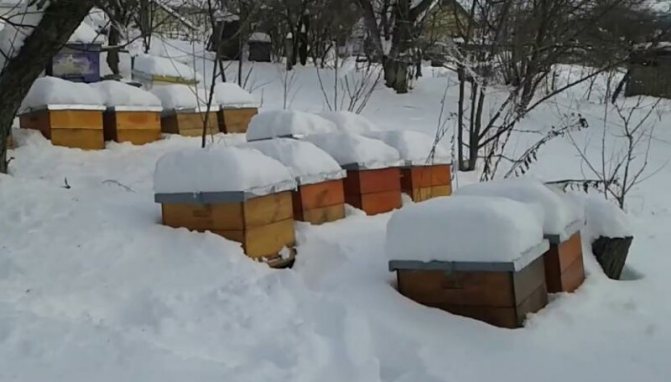

Difficult choice
Having found out that it is still necessary to insulate the hives for the winter, the beekeeper will certainly face a choice: where is it better for his bees to winter? There are two ways of bee wintering: in Omshanik (or winter road) and on the street. And, as usual, each of these methods has its advantages and disadvantages, supporters and opponents, and discussions about which one is better continue to this day.
Each type of Omshanik speaks for itself: the aboveground one stands on the ground, the semi-underground one is deepened into the ground up to one meter or more, but so that some of it still remains above the surface, the underground is built in such a way that its ceiling is at ground level.
It is no coincidence that even Canadian beekeepers, who for several decades in a row preferred wintering their bees in heated premises, at the beginning of the 21st century began to switch to outdoor wintering.
More details about the features of both methods of wintering bees can be found in this video.
Preparing families for wintering
It is necessary to build up the mass of young, healthy, unemployed workers. Old individuals are not needed for wintering bees: they will not survive until spring anyway. Only honey is used in vain for their content.
- We calculate the time until which the uterus should lay eggs. We subtract a month from the date of the last flight in your area. So that the freshly hatched bees have time to fly around before wintering.
- Until that time, we stimulate egg-laying with stimulating feeding (in the absence of a bribe). When maintaining an apiary, we replace queens annually or after a year: young worms take longer.
- We carry out therapeutic measures. We treat it twice for varroatosis, with which, alas, all apiaries are now infected. The first time - at the end of the main bribe: without reducing the number of parasites, it is impossible to raise full-fledged workers. The second time - after the emergence of the entire brood: in its absence, the efficiency of any processing is maximum, the entire mite is in the nest. If the apiary is infected with other diseases, we treat it. Before the formation of the club, it is good to give medicinal feeding for the prevention of nosematosis.A good wintering of bees is impossible if we have sick, mite-sucked insects!
- We try to keep older workers busy with sugar syrup processing, drying and repairing damaged frames. To do this, we give all the syrup fed in large doses immediately after the main bribe.
- If it's a good day for flying around, and the insects are already in the club, you can try to induce them to fly out by knocking, noise, partial analysis of the nest. The later they fly around, the less fecal load on the hibernation of bees.
We allocate spare queens to small families. There is usually enough time to form cores after the main flow to the mature mother. The queens will fly around and have time to grow enough young individuals for a good wintering of the bees. Such families are inexpensive in terms of cost: there are enough workers and queen cells at this time, with minimal efforts of the beekeeper. Keeping 10% of spare queens from the number of families in the apiary helps to save the lost queen from death. Or develop it into a full-fledged unit next season, as in the video.
We begin preparing for wintering immediately after the main flow, simultaneously with the selection of honey. Even then, sorting through the frames, we leave brood and low honey brown (I prefer their queens in spring), form cores for spare queens, clean the folds, prepare and distribute sugar syrup. We carry out therapeutic measures.
How to prepare a hive for winter
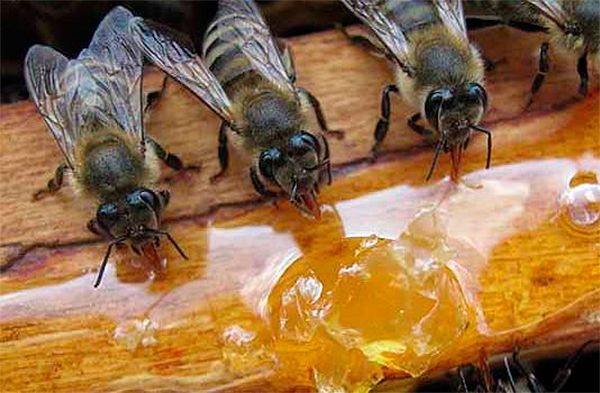

Preparation of hives for wintering begins in the fall. If the apiary is slightly neglected, they begin to look into the houses from the end of August. During the examination, the beekeeper reveals:
- Brood condition. An excellent indicator is considered to be its increase or preservation unchanged, but in good quality. With a decrease in brood, the beekeeper urgently takes measures to restore it. If the brood in the family has stopped, the bees from this hive will not survive the winter.
- A healthy uterus. The queen should be all right. With a weak or sick uterus, a family cannot be left in the winter.
- The amount of feed. In the hive for the winter there should be a sufficient amount of honey and bee bread. With small stocks, the beekeeper takes measures to increase them.
- The presence or absence of disease. Even if the colony is healthy, the bees and the hive are sanitized in the fall.
- General condition of the house. The hive is inspected for cleanliness inside, the integrity of the structure. Be sure to assess the condition of the honeycomb, prepare the nest for winter.
Inspection is the first step in preparing the hives for winter.
The video tells how to avoid mistakes when preparing for winter:
Preparing hives for wintering
In order to keep the bee hive warm even in severe frosts, the wooden house in which the bees are kept should be carefully insulated. It is usually recommended to do insulation on the sides and bottom with polystyrene foam, pieces of roofing felts, burlap, any dense materials. The main thing is that there are no gaps left. It is recommended to raise the house in the fall above the ground by placing it on high, stable wooden pegs.
With the onset of a long-term severe cold snap, experienced beekeepers advise to dig the house around the edges with snow, but it should not be allowed to come into contact with the walls. The most destructive thing when bees overwinter outdoors is high humidity. If snow gets into the tray, it will melt inside, this is contraindicated. Already in February, you need to dig out the house and shovel the snow away.
Be sure to leave small holes in the house for ventilation and airing. However, before that, it is worth checking that autumn rain and snow do not fall into holes or crevices. It is necessary to ensure that the branches of trees, shrubs do not touch the walls in the wind, this will disturb the hive. You will also have to drive away annoying crows and magpies from the apiary - they make too much noise.
When bees winter on the street, the correct formation of the club and the hive is extremely important: in severe frosts, an incorrectly located club perishes from hunger with sufficient feed reserves. The point is its low mobility.
Normally, it forms in the lower part of the middle (when viewed from above) of the nest, a little closer to the tap hole. During the winter, it slowly rises on the honeycomb warmed up by the warm air above the club. Bees in easy movement: like penguins, they alternate on the cold edge, some of them crawl into the vacated cells for compactness.
When keeping an apiary in multi-hulls, the device of the hive during the wintering of bees requires overcoming a small "honey-free" barrier between the frames of the two hives. And if they come across a large space of the left low-honey frame during the wintering of bees on the street and in severe frosts, they will not be able to overcome it. And they will die of hunger, regardless of the presence of any reserves of honey behind the "barrier". Here is a video of the club's location in October.
Therefore, we try to leave only frames filled with bee food at least 2/3.
We arrange full-fledged ones alternately with less filled ones. The brood should be at the bottom, this is where the club will be formed. It is better to remove the ceiling pillow, then it will fit exactly on the bottom. Back in the nest when the cold weather sets in. Yes, for the winter, the insulation must be dried, the pillows, preferably unpolished. It's all about physics: if you insulate the nest too much and limit ventilation, the dew point will fall on the inside of the nest.
Condensed water - dampness in the nest, fermented honey, as a result of diarrhea and death during the wintering of bees in the wild.
It is not necessary as a heater to chase padding polyester, cotton wool and other highly effective materials with a low heating coefficient. Wood shavings in a pillow made of cheap fabric are just that. Warming hives for the winter should not be excessive! Hibernation of bees outside implies a strong temperature difference in the nest and outside. Having overdone, we will achieve condensation of moisture from the air exhaled by wintering insects in the hive. With inevitable dampness and accompanying troubles: the wintering of bees will be bad, lucky if they don't die ...
We look through the hives so that there are no cracks. We put entrance barriers from mice. In autumn, we keep bees with reduced entrances: apart from keeping warm, small openings are easier for bees to guard. And then wasps and other "honey-loving" insects like to enter the nest when it gets cold: bees are inactive and guard the entrances poorly. The device of the hive, where the lower entrance is at the level of the bottom, carries an additional danger.
The lower notch can be clogged with submergence. If necessary, clean the notch with bent wire during hibernation. Better yet, insert an extra stretcher when preparing for it. When maintaining an apiary at any time, it is worth correlating the size of the entrance to the strength of the family, but especially - in the fall and in the period without tipping. When keeping bees, beekeepers often notice subtle flaws and manually make improvements to the insect house. In this video, the beekeeper, while keeping the family in the Beebox hive, showed the correction of some of his shortcomings.
It is good to cover the entrances from the wind and the sun with shields from the material at hand. The sun during a thaw can induce oviposition too early in the uterus, especially in southern breeds. The wind blowing into the notch - fast and strong cooling of the nest. In addition, birds can disturb the bees by tapping with their beak near the nest. And pecking at the crawled out insects. Wintering of bees in polystyrene polystyrene hives is often easier than wooden hives.
When kept in them, there is a plus: expanded polystyrene hives keep heat better. But they are too light. It is advisable to put a brick on the roof of expanded polystyrene hives, not for the winter, but for the whole season. For protection from strong winds. You can make expanded polystyrene dividing boards. Sometimes they are more convenient than insulating pillows when supporting families: they are easily placed in the right place. With a small volume, it protects well from the cold.
Insulation of the hive
When bees hibernate in the wild, the beekeeper is limited in its control and assistance to families, so "little things" should not be missed.There are no trifles, everything is important. Families in multi-body hives should winter in 2 buildings, even weak ones: the height of the Rut frame is not enough for high-quality wintering of bees.
It is easier for the club to move upwards than to the side!
Weak colonies and spare queens can be placed two in one hive with a blank partition between them. The hives standing on high stands should be lowered, but not on the ground, but on low stands, for example, bricks laid flat in 1 row. Another way to keep spare queens in multi-body hives: we place the nucleus in the upper, additional body. Having nailed down the false bottom, the partition must be solid! External insulation of the hive with snow is suitable if the winter in your area is long and without thaws. For such a warming of the hive for the winter, we cover it with spruce branches, wrap it with a material that passes through steam (not with tar), then sprinkle it. No knocking: any excitement for wintering insects is harmful.
Insulating hives - step by step guide
So, we begin directly warming the hives for the winter. The algorithm of actions in this case should be as follows.


Note! The specific actions for thermal insulation depend on where the bees will spend the winter. As far as we know, they can spend the winter in a special winter house, in a cold room (basement), or simply outside. In the latter case, both the hive and the nest must be insulated without fail.
Step one. If the bees are together, then they will be not only warmer, but also, so to speak, more fun. Therefore, you should first line up all the hives in a row so that the number of blown walls is minimal. Obviously, such a "construction" should be done only when you have nowhere to move the hives during the frost (who does not know, this kind of room is called Omshanik).
Advantages and disadvantages of the method
Benefits:
- Lack of large investments.
- No need to transport hives during the first spring and cleaning flights. By the way, the latter are more and more often recorded in the midst of winter due to unstable temperature conditions outside.
- Earlier development of bee colonies. Wintering inside a hive located on the street is more active than in Omshanik, therefore, in the spring, families that winter on the street are also more active and productive. It has been noticed that bees in the spring, after wintering on the street, often clean up the dead soil themselves.
Among the disadvantages of wintering on the street are:
- Plenty of honey and sugar syrup for feeding - frames should be sealed at least 2/3 of the height.
- Difficulties with placing hives in a non-solar, protected from wind and precipitation area
- The need to think over protection from birds that can gouge the hives, spoiling them, and at the same time luring the bees in order to further devour them.
- The need to monitor changes in weather conditions, snow cleaning, and, if necessary, rearrange the hives.
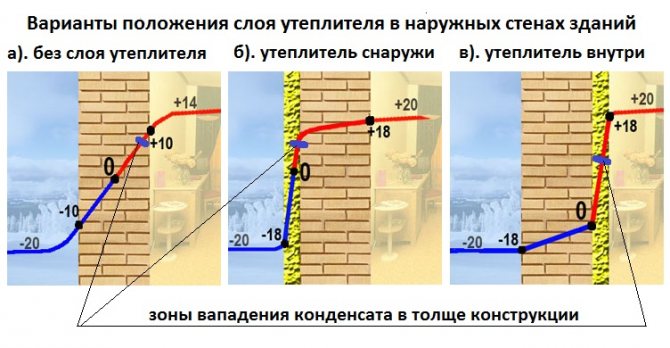

Providing ventilation in the hive during the winter
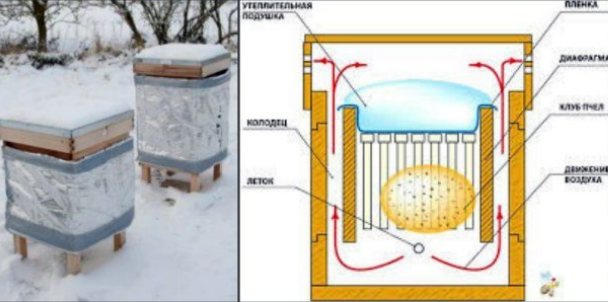

Ventilation of the hive is provided in winter in 3 ways:
- through the bottom (tap holes and mesh bottom);
- through the top (holes in the lid);
- through the bottom and top.
Each method has its pluses and minuses. The choice is made individually, taking into account the design of the hive, the method of wintering, the strength of the family used to insulate the material. One thing is important - ventilation is required. Moisture forms inside the hive and must be removed.
It is recommended not to close the hive entrances for the winter, but to equip them with adjustable dampers and cover them with a net. For expanded polystyrene and polyurethane foam hives, this will not be enough. Additionally, the blank bottom is replaced with a mesh bottom. It is important not to overdo it with ventilation. If a draft occurs, the bee colony may die.
Proper ventilation is based on three rules:
- The air supply must be uniform. This will keep the inside of the hive at the optimum temperature and humidity in winter.
- A well-insulated and ventilated omshanik helps to avoid drafts in the hive.
- It is not often, but periodically it is necessary to check the condition of families. By the behavior of insects and their number, the beekeeper will determine how much to open or cover the entrances.
Natural materials used for insulation help to avoid drafts, keep warm and do not interfere with ventilation.
In the video, you can learn more about the insulation and ventilation of the hives:
What entrances to open in the hive for the winter on the street
It is recommended for ventilation to open the upper and lower entrances in the hive in winter when the apiary is hibernating outdoors. A grid is installed as barriers. If there is no upper notch in the hive, 10 cm of the lap is bent at the back wall. The ventilation gap is covered with hay, moss or other insulation that allows air to pass through.
Checking bees and inspecting their winter ball
The main rules for examining a ball of insects:
- the houses should be installed so that, even during a heavy snowfall, it was possible to move freely between the hives without touching them with clothes;
- the covers are removed in calm weather, trying not to make noise;
- try to carry out the inspection in cloudy weather, since they are sunny
Providing bees outside with food
Bees in hives, whose food reserves are about 25 kilograms or more, hibernate outside without additional feeding. To fulfill this condition, they should be taken out in the fall for late honey harvests, making sure that the insects do not weaken. Proper maintenance of bee colonies in winter requires the presence in each house of 2-3 frames with stocks of bee bread, several frames with honey. If there is not enough feed, the families will have to be supplemented with sugar syrup or sugar-honey mixture.
How to insulate a hive for the winter
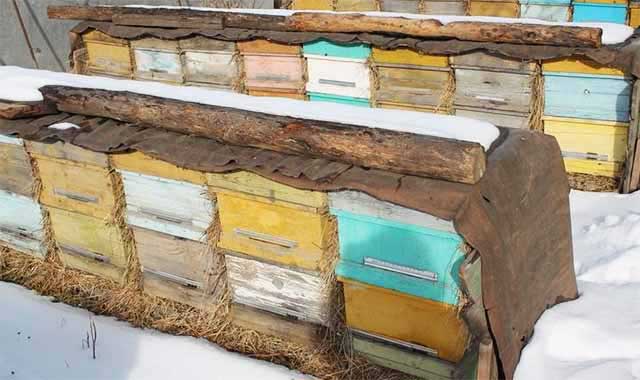

The process of warming the hives is a mandatory step in preparing for winter. The procedure is simple, usually consists of standard steps:
- The hives are covered with polystyrene foam, mats made of straw, reeds, but they cannot be completely clogged. A ventilation hole is left on top for air exchange.
- In winter, hives are placed on stands. If this is not done, the bottom of the house will freeze from the ground.
- When there is a lot of rainfall, snow walls are poured around the hives to protect from the wind. Height up to about half of the house. Moreover, it is important to make an indent of about 20 cm from it. It is impossible to cover the bee housing with snow.
- If there is a blizzard outside, the beekeeper should dig out the hives as soon as possible. Snow covers the ventilation holes. Inside the house, humidity increases, and when the snow melts, water will enter the nests through the notch.
Simple rules of preparation will help to overwinter the apiary on the street.
Why do you need to insulate bees for the winter
The insulated winter hive guarantees the safety of the family. At the end of the honey collection, the bees inside the hives gather in clubs, warm each other. When the temperature drops below the permissible norm, insects increase their activity and begin to consume more food. Artificial warming of the apiary by the beekeeper guarantees the safety of the bee colonies. Additionally, feed is saved.
How can you insulate your hives?
Natural and artificial material is used for insulation. The main requirement is to protect insects from the cold frosty wind. It is easier for bee colonies to survive frost than sharp gusts of icy wind.
How to insulate a hive for the winter outdoors with foam
If the apiary hibernates outside, foam is considered a good insulation for the hives. Styrofoam is great, but it's more expensive. Preparation for insulation begins with cutting the foam boards of the desired size. Fragments are attached to the hives with dot-tacks of glue. Houses must be placed on stands. The bottom of the hives for insulation is pasted over with foam.
The downside of the material is the attractiveness of a loose structure for rodents. After warming the walls of each hive with foam, it is advisable to protect them with plywood, slate or tin. Another disadvantage of polystyrene is the impermeability of air. A thermos is formed inside the hive.The beekeeper will have to deal with ventilation adjustments. With warming, the tap hole is opened more, and when it gets colder, it is slightly covered.
Warming bees for the winter with natural materials
Using natural materials, you can similarly prepare the hive for wintering, if you use them correctly for insulation. Loose insulation of moss, sawdust, small straw is placed in covers made of durable fabric. The resulting pillows are placed under the lid of the house. To protect against bees, a net is laid under the insulation.
Outside, insulation is carried out with blocks of hay or coarse straw. From the rain, the natural material is covered with a tarp. The disadvantage of this method of insulation is similarly the susceptibility of thermal insulation to destruction by rodents. In addition, cold bridges are formed due to the loose fit of the blocks.
Wintering methods
Wintering is an important period in the life of bee colonies, since the future of the entire apiary and the harvest depends on it.
There are several ways of wintering:
- in a special house called Omshanik;
- in the wild;
- in a pre-insulated room, namely in a bathhouse, basement, shed or greenhouse.
The beekeeper starts preparing for this event in advance.
It is important to check all the houses so that they are free of dampness and rot, various infections. On condition of preliminary preparation, the winter period passes without the death of families.
At this time, it is necessary to maintain a stable humidity and air temperature, to ensure good ventilation. Activities are performed before the onset of frost and cold weather.
Outdoor wintering
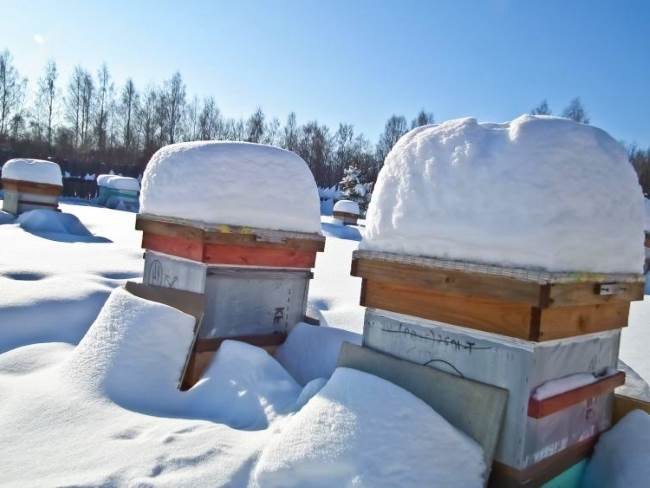

With the onset of cold weather, the bees form a winter club. This is necessary to save power and maintain a certain temperature.
The variant of wintering insects outdoors under the snow is used by beekeepers with extensive experience. It is required to eliminate all cracks by insulating in the fall and covering the hives with snow.
First you should check if the houses are well protected from the wind. Trees and other structures can be shields. It is possible to insulate the walls with slate or roofing felt.
Wintering of bees in Omshanik
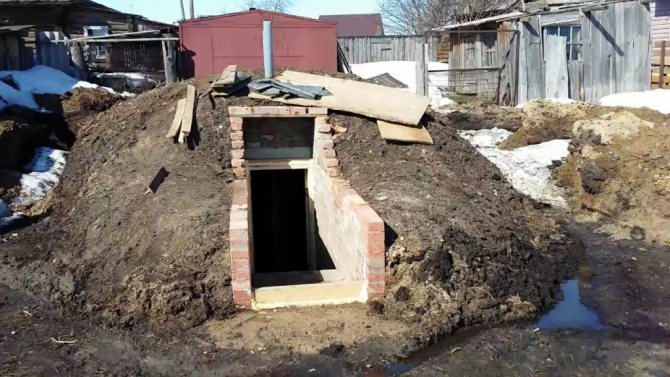

The site chosen for the building must be dry and protected from the wind. Mice should not enter omshanik; noise and light should be excluded.
Distinguish between aboveground buildings, underground and semi-underground. The most popular are underground. The hives are hidden to a depth equal to the height of the walls. In winter, they will have a stable temperature, and in spring it will be reduced, which is necessary for the successful completion of wintering. Omshanik walls should be rubble or brick, wooden ones often deteriorate with fungus.
Indoors
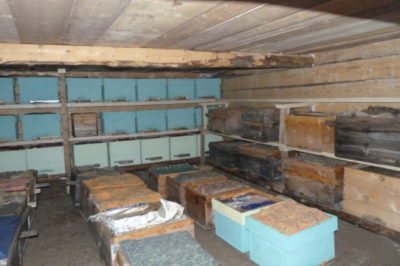

Some beekeepers set up huts with bees in a spacious shed. Wintering in a barn requires special preparation and wall insulation. The floor should be covered with a thick layer of sand, straw and dry leaves and branches. The wall must be protected from snow, rain, winds. To do this, you can fence it with slate or boards.
Beehives are installed in one row on boards or ground, with entrances to the exit. Make sure that the work with the entrances is done correctly. If there are cracks in the walls, they are carefully sealed so that rodents and bright light do not penetrate inside. The holes are closed with a dense mesh. Pine cones can be used if desired. An important condition is that it must be dry, warm and quiet inside. The top of the house for insulation is covered with spruce branches, straw, leaves, needles.
Why do bees die in winter
Mortality is influenced by various factors, including poor wintering. The correct content will help to minimize or completely eliminate:
- weak families;
- death of the uterus;
- hunger;
- high humidity;
- low temperature;
- diarrhea;
- illness;
- rodents.
Excessive moisture is determined by the presence of mold. The main factor is inadequate ventilation of Omshanik. Improper treatment for diseases also increases moisture readings.
The formation of excess moisture leads to souring of honey.The consequences are the death of insects due to hunger. Possible lack of feed due to crystallization of honey, cold.
We offer you to familiarize yourself with beetroot caviar without onions
Bee diarrhea can be a common consequence of death. When brood appears in the last months of autumn, proper flight does not take place. Large amounts of stool accumulate. The full intestines of young individuals lead to the pestilence of the entire family.
Honeydew honey can also provoke diarrhea. Honey varieties with the highest content of the active component are not suitable for nutrition during the wintering period. These include all varieties of a dark color. It crystallizes faster and sour.
The absence of a uterus is another factor of pestilence. When bees search for a queen, the state of the club is disturbed. The insects can no longer gather again, an even submergence occurs.
An even submersion is caused by an increased temperature in the house, eight degrees or excessive noise and bright light.
The podmore in the form of a slide says that the bees did not warm up enough, and the cause of death was hunger. Moving behind the feed, the formation of several small tubers is possible.
Infectious and invasive diseases become the cause of death of bees. Some of them:
- viral paralysis;
- salmonellosis;
- calcareous, saccular brood;
- rotting of larvae.
When diseases are eliminated, special treatment is carried out. It is necessary to fight the pathogens correctly so that this does not become another cause of the death of bees.
Harvesting feed
July in beekeeping is the most favorable period for bees' forage procurement. To winter, you need to prepare up to 30 kg of product. To do this, on each side of the nest, a pair of frames with honey are placed; you can remove the same frames in storage in order to expose them later, in October. For the winter period place 20 kg in the nest, and the rest of the stock is stored in a warehouse with a constant temperature and normal humidity in order to minimize the crystallization of honey.
Light varieties of honey are preferable for wintering because they contain few minerals (linden blossom, meadow grasses, apple blossom). If the procurement of light honey in the required amount did not take place, then half of the stock can be replaced with sugar. Do not allow honeydew impurities in the harvested honey, it can lead to the death of the family. Therefore, fodder stocks are absolutely necessary. check for honeydew... You can do it yourself:
- prepare lime water by shaking quicklime in distilled water until the color of milk;
- the settled clear water is drained into a separate vessel;
- mix honey from different parts of the nesting combs in a glass;
- mix distilled water - 1 part, honey - 1 part, lime water - 2 parts;
- Shake the mixture and bring to a boil.
If, as a result, there is a strong turbidity, precipitation of flakes - honey is contaminated with honeydew... It is better not to use such honey for wintering, but replace it with another or sugar. In September, the weather is still warm, and this is a good time for feeding bee colonies, for which three-liter syrup feeders are set up every three days twice a month.
High-quality assembly of the hive and the presence of ventilation is the key to the survival of bees
When insulating the hives, special attention should be paid to ventilation: it not only provides the bees with oxygen, but also removes excess moisture from the hive. Its absence or insufficiency is a sure way to weaken, and even death, the bee family.
Many beekeepers, especially beginners, are afraid to re-insulate the hive or equip it with excessive ventilation. This should not be feared simply because such concepts do not exist in beekeeping. Most often, these terms mean insufficient ventilation. Some are engaged in regulating the opening of the entrances depending on the outside temperature - this is not necessary, it is enough just to set the areas of ventilation openings in a wide temperature range at the beginning of wintering, based on 1 sq. see the street. Since the rate of air exchange is determined by the capacity of the club, it is simply not possible to ventilate more than it is.
Growing bees in the winter
Caring for the bee colony before wintering
Build-up of honey insects plays a huge role before hibernation because there is one tendency in relation to old bees. The fact is that they worked for a long time during honey collection, wasting their own strength. Consequently, their bodies are depleted and they become unable to withstand the winter. Therefore, for building up, only those bees are used that appeared in August and later. But here, too, there are some nuances. It turns out that it is necessary to leave those bees whose eggs are laid in the period from August 1 to September 20 at the most. It is necessary to feed such young animals with honey syrup with a low density, and the portions should be minimal.
When to prepare bees for winter? The formation of hives for the winter is carried out before the final period of the main bribe, therefore, it is necessary to prepare the young in a timely manner. You cannot use those queens whose age has exceeded a couple of years. Young families endure wintering much easier and consume much less food. Harvesting feed should be done before the end of the last honey collection, otherwise the bribe may fail. And it is after him that honey insects begin to prepare themselves on their own. That is, drive out drones from the hive, fly less and lay eggs less. Consequently, laying and harvesting of honey is greatly reduced. In the same period, old individuals begin to die off.
Wintering in special winter roads
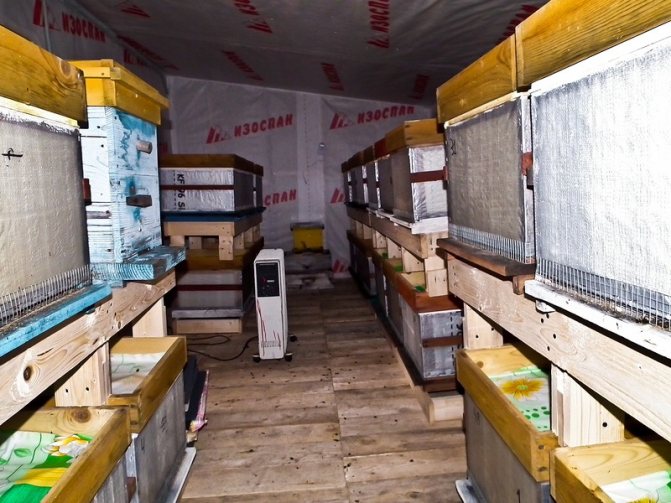

During long winters, beekeepers build special winter roads for hives. Even in summer, it should be well dried, the ceilings and walls should be whitewashed with lime, and sand should be poured onto the floor.
Bees are brought into the winter house after the onset of persistent cold weather. The roofs are removed from the hives. If the temperature is between 0 and 4 ° C, you can remove the warming cushions. The door should be left open in order to reduce the temperature in the winter house.
Mistakes of novice beekeepers when warming
1. Too insulated hive. In general, according to experienced beekeepers, there is no such thing. If there is an excess of heat, it is the owner's mistake. Most likely, the clue lies in insufficient ventilation. 2. Excessive ventilation. There is an unspoken rule here: the higher the temperature around the hive, the larger the hole diameter you choose. The bees will live well only when the proportion between reliable insulation and optimal ventilation is observed. 3. Often newcomers use fiberboards instead of straw for insulation, not knowing that the inhabitants of the hive are not indifferent to this material. To prevent the bees from gnawing them, saturate the plates with linseed oil. 4. Don't underestimate rodents. They can greatly spoil your nerves and honey "harvest". Bees cannot stand the smell of mice, queens do not lay eggs in the cells of the frames, where their traces remain. Damaged honeycombs are not completed by insects.
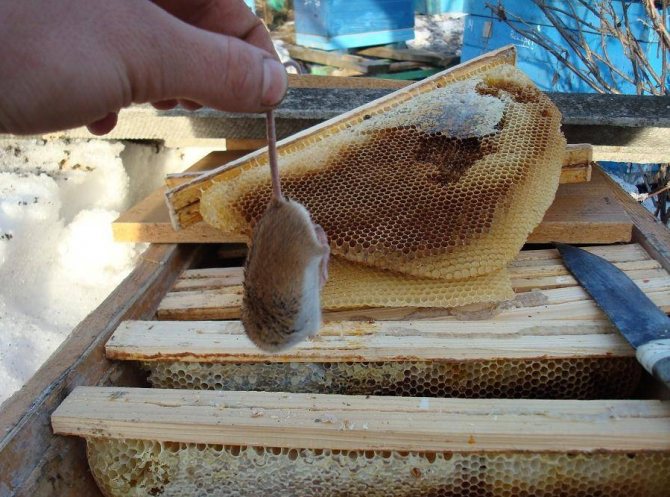

In the worst case, in the spring, bees may not return if they had a chance to spend the winter with rodents. They also cause a lot of trouble to people, gnawing through the insulation material, destroying the honeycomb. Therefore, it is imperative to fight them with all existing methods.
Temperature and lighting
To create favorable conditions for the safe wintering of bees, it is necessary to strictly observe the temperature regime in the hives. It is necessary to achieve an optimal temperature at which excessive air humidity will not form in the winter house.
So, during the wintering of bees in oshmanik, the temperature should be -2 - + 2 ° C. If the temperature is higher, then additional ventilation of the hive may be required, as a result of which wintering can significantly deteriorate. But it is not recommended to create additional heating in the winter house at all.
As for the lighting, it is desirable to maintain a balance here, that is, it is impossible for the bees to be in complete darkness, but at the same time they also do not want too bright light.
Ventilation of the hive in winter
Another important feature is the presence of ventilation, through which in no case must not penetrate snow or rain... The fact is that without airing, too high a temperature forms inside the nest, and this is harmful to the bees. In fact, there are 2 options for ventilation. Firstly, this is a slightly open entrance, but here you should know that at temperatures below -15 degrees, it can mercilessly become covered with frost. Therefore, if there are such frosts in your region, then you need to make small holes in the ceiling and slightly expand the entrance. For holes, 5 mm is enough.
The second option provides for the installation of a taphole both from above and from below, thereby eliminating moisture and, at the same time, carbon dioxide. But, there is one significant drawback, it is a draft. To avoid it, you can make an additional valve that will allow you to fully regulate the air flow.

